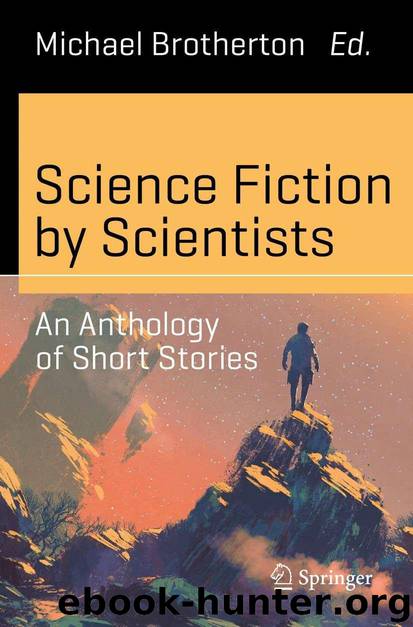Science Fiction by Scientists: An Anthology of Short Stories (Science and Fiction)

Author:Michael Brotherton
Language: eng
Format: azw3
Publisher: Springer International Publishing
Published: 2016-11-14T16:00:00+00:00
Afterword
I enjoy blending hard SF with mystery, and with my background as a payload flight controller for seven Shuttle missions plus several ISS increments, it seemed a logical notion to set a mystery aboard a near-future Space Station. I had advice from friends and former colleagues Dr. James K. Woosley and Larry Bauer.
I would like to specify I created a communications loop for this story. Normally private conferences (medical etc.), occur on Air-to-Ground-1, locked down outside intended conversants. But since that’s the main comm between Houston and the “guys upstairs,” I envisioned AG-3 expressly for any private comm from Earth to spacecraft.
For those interested, I’ve listed some references on subsequent pages for more information, starting with Wikipedia and moving to more sophisticated sources. But to summarize the core issues at the heart of this story…
Phenolphthalein has been in use for over a century as a laxative, though concern over long-term carcinogenicity has caused it to be removed from store shelves in recent years. However, it is also commonly used in chemical titration as a colored marker to denote pH in the solution being tested. I have myself used it for this purpose, and a skilled chemist can determine pH of a solution quickly and accurately with it, without need of additional or more sophisticated instrumentation. But titration equipment is gravity-based, so a space-based lab would need automated equipment. Arguably there are other means of instrumenting a solution to determine pH, but as aforementioned, a skilled chemist is just as fast, and in some cases, more accurate.
It’s a concern that long-duration space flight may cause mental issues, even up to and including psychotic breaks, due to the relative isolation and very restricted environment — it is not, after all, as though one can go for a relaxing stroll after dinner! If those factors are combined with brain damage due to impact/skull fracture, serious psychological problems might ensue.
Also microgravity effects upon skeletal systems are known. It seems there’s a glitch that develops between systems breaking down old bone and those building new bone, such that in microgravity, the new bone systems significantly reduce activity, if not outrightly shut down, while old bone systems maintain, or even possibly increase, activity. More, it produces permanent damage: while the bones remineralize upon return to a gravity environment, they remain less dense than before the spaceflight. It is perfectly reasonable, therefore, to postulate a point of no return — where bone loss has become so great, the skeletal system cannot survive return to a gravitational environment.
Since bone breakdown/deposition systems are hormone-regulated, a reasonable means of attempting to circumvent bone loss might be artificially manipulating those hormones. However, we’re still working to understand this synergy, and what works on Earth might not necessarily work on everyone in space. More, if we add in a postulated data scandal such as has been uncovered in a couple of different fields in recent years, there is the potential for harm over and above the normal spaceborne bone loss.
I’d like to
Download
This site does not store any files on its server. We only index and link to content provided by other sites. Please contact the content providers to delete copyright contents if any and email us, we'll remove relevant links or contents immediately.
| Aeronautics & Astronautics | Astronomy |
| Astrophysics & Space Science | Comets, Meteors & Asteroids |
| Cosmology | Mars |
| Solar System | Star-Gazing |
| Telescopes | UFOs |
Tools of Titans by Timothy Ferriss(8303)
Turbulence by E. J. Noyes(7977)
Secrets of Antigravity Propulsion: Tesla, UFOs, and Classified Aerospace Technology by Ph.D. Paul A. Laviolette(5330)
Astrophysics for People in a Hurry by Neil DeGrasse Tyson(5151)
Room 212 by Kate Stewart(5068)
Design of Trajectory Optimization Approach for Space Maneuver Vehicle Skip Entry Problems by Runqi Chai & Al Savvaris & Antonios Tsourdos & Senchun Chai(5037)
Pale Blue Dot by Carl Sagan(4950)
The David Icke Guide to the Global Conspiracy (and how to end it) by David Icke(4654)
A Journey Through Divination and Astronomy by Publishing Pottermore(4363)
Goodbye Paradise(3761)
Apollo 8 by Jeffrey Kluger(3664)
COSMOS by Carl Sagan(3585)
Losing the Nobel Prize by Brian Keating(3518)
The Five People You Meet in Heaven by Mitch Albom(3515)
How to Read Water: Clues and Patterns from Puddles to the Sea (Natural Navigation) by Tristan Gooley(3430)
Brief Answers to the Big Questions by Stephen Hawking(3392)
How to Read Nature by Tristan Gooley(3290)
The Order of Time by Carlo Rovelli(3162)
A Brief History of Time by Stephen Hawking(2991)
